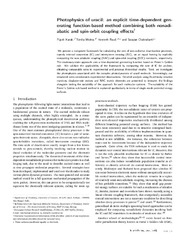Photophysics of uracil: an explicit time-dependent generating function-based method combining both nonadiabatic and spin-orbit coupling effects
Permanent lenke
https://hdl.handle.net/10037/33206Dato
2023-02-14Type
Journal articleTidsskriftartikkel
Peer reviewed
Sammendrag
We present a composite framework for calculating the rates of non-radiative deactivation processes, namely internal conversion (IC) and intersystem crossing (ISC), on an equal footing by explicitly computing the non-adiabatic coupling (NAC) and spin–orbit coupling (SOC) constants, respectively. The stationary-state approach uses a time-dependent generating function based on Fermi's golden rule. We validate the applicability of the framework by computing the rate of IC for azulene, obtaining comparable rates to experimental and previous theoretical results. Next, we investigate the photophysics associated with the complex photodynamics of the uracil molecule. Interestingly, our simulated rates corroborate experimental observations. Detailed analyses using Duschinsky rotation matrices, displacement vectors and NAC matrix elements are presented to interpret the findings alongside testing the suitability of the approach for such molecular systems. The suitability of the Fermi's golden rule based method is explained qualitatively in terms of single-mode potential energy surfaces.
Forlag
Royal Society of ChemistrySitering
Karak, Moitra, Ruud, Chakrabarti. Photophysics of uracil: an explicit time-dependent generating function-based method combining both nonadiabatic and spin-orbit coupling effects. Physical Chemistry, Chemical Physics - PCCP. 2023;25(11):8209-8219Metadata
Vis full innførselSamlinger
Copyright 2023 The Author(s)


 English
English norsk
norsk